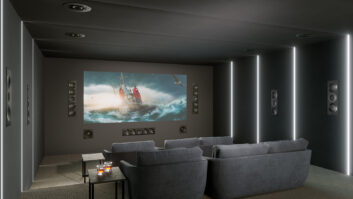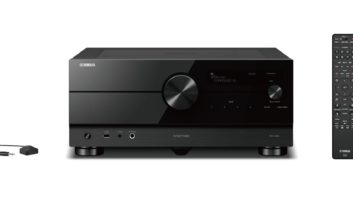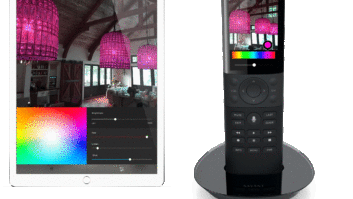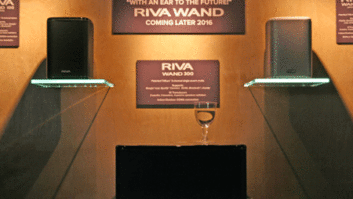The transition from analog to digital has been a head-spinning technological change, with the custom installation channel winning out as one of the biggest benefactors of this development. The savvy that consumers have recently displayed within the digital realmacquiring vast music collections via the Internet, embracing everything HDbodes well for newer technologies that are branching off from digitals success and expanding the possibilities of multi-room audio and video.
Wireless Distribution
Wireless distributed audio systems may be music to the ears of integrators who are now taking a good hard look at the vast and largely untapped market of existing homes. In residential data networking, wireless solutions have gone from a rarity to near-ubiquity, as the ease of installation and the cost savings from not having to run cabling became better known among consumers. It is only natural that these same consumers start to look for wireless approaches to multi-room audio.
Niles Audio’s IntelliControl ICS features a GXR2 receiver (top), keypads and touch screens (center, including wireless iRemote, center-left), and source modules (bottom), which slide into the source bay on the GXR2. Module at lower right is RS232G Bidirectional Gateway.
The only problem with this approach is that distributing audio while maintaining quality levels consistent with high-fidelity sound puts demands on the network that few off-the-shelf wireless networking technologies can meet. Nevertheless, there are a few such systems now on the marketfrom Sonos and Control4 to name a fewand many more will follow.
But is a product that doesnt need wires the right product for custom installers? It works well for many reasons, explained Kostas Reissis, Sonos director of distribution channels for U.S. and Canadian custom installers, who highlights speedy installation as one big benefit to wireless. Without the need to [pull] wire, dealers can do substantial (six- or eight-room) installations in a day or less, depending on how elaborate an install the customer is looking for.
Niles Audios IntelliControl ICS system is a good example of this retrofit technique in action. In some respects, the ICS system is conventional in that it uses a central receiver head end containing the power amplifiers and speaker wire fanning out to the various rooms to be served. Control of the system, however, is wireless, using 802.15.4/ZigBee technology, which operates in the 2.4 Ghz radio frequency (RF) band. Niles wireless handheld remotes, known as iRemotes, use 802.15.4 wireless links to talk to each other, and to the central receiver, the GXR2. The iRemotes take advantage of mesh networking, so that even if one of them is out of range of the receiver, another iRemote will forward the message traffic. Thus, even if the speakers need to be wired, the control system doesnt have to be.
You could put in a GXR2 with whatever source cards that you want, pull out all the volume controls, and splice the wires together, and give the customer a couple of iRemotes, explained Keith Kennedy, Niles director of product development. Thats all they need to run their entire system. The iRemotes display metadataincluding CD cover artto the user, as well as deliver control information to the system.
New Audio Distribution Systems
Russound is launching a flagship multi-room audio system, known as the E-Series, which is driven by the ACA-E5 controller amplifier and uses analog transport, but IP for control. Its really an evolution from R-Net, said Ian Popken, Russounds director of product development, in reference to the companys previous top-of-the-line distributed audio system. In this case, by adding IP capability on top, were able to do things much more robustly.
The E5 handles up to 12 sources and eight zones, with target power output in the 40-50 watt-per-channel range. To control the system, the company also plans to introduce the KLK-E5 Click Wheel Keypad, which uses a touch-ring technology similar to the navigation wheel on an iPod. Russound dealers will have to go through the companys Sphere Certification program before being authorized to sell the E-Series.
Colorado vNet has chosen the digital transport route for its Vibe multi-room audio system. We use ethernet, said Ben Beierwaltes, marketing director for the company, and we use off-the-shelf switches and routers, so we have nothing special there…In larger systems that have a lot of data moving; youll have to move up to an IGMP-managed switch that can route all the streams efficiently.
Vibe uses a distributed architecture. Power amplifiers for the speakers (35 watts per channel) are part of the Vibe touch screens, which go into each zone. The strength of IP-based multi-zone audio systems is the infinite number of sources and zones that they can handle. We have tested and can confirm working, I believe, 20 sources and 40 zones, Beierwaltes said. But Im sure we can go higher than that.
Digital Network Distribution
Sonos, the California-based manufacturer of the Sonos Digital Music system, has tapped into the ease of downloading music digitally by building its system as an extension of the home network, which in turn scours various computers and network-attached storage devices, looking for music files. Once found, the system then indexes those files, so users can pick songs by artist, title, or genre. Beyond this, Sonos has struck deals allowing users with a broadband Internet connection to stream music directly from the Internet-based Rhapsody music collection and Pandora music servicewithout going through a PC.
Once we started seeing digital music, we went from customers having to have stacks of CDs, to having the capability of storing all of their music on some hard drive, said Reissis. Once that technology was available, it became a lot easier for customers to store music and to control it.
SpeakerCrafts most recent introduction in multi-room audio is the companys MODE (Music On Demand Experience) keypad, which features a scroll wheel and 3.5-inch, 64-color display, giving users iPod-style access to sources and music, complete with metadata. Theres also a large, dedicated volume knob, for quick control of that critical parameter, and eight physical keys.
SpeakerCraft has three levels of multi-zone audio controllers, ranging from the six-source, four-zone, 30-watt/channel MZC-64 to the six-source, six-zone, 30-watt/channel MZC-66, and the eight-source, eight-zone, 50-watt/channel MZC-88. All of SpeakerCrafts keypads work with all of the MZCs. Up to six iPods can be used as sources in the systems. Interface with Crestron and AMX systems is via RS-232.
Vantage Controls’ Axium 450AV multi-room amplifier is an eight-source, four-zone controller and amplifier that also contains an 8×4 video switching matrix.Vantage Controls, a mainstay in lighting controls, made its entry into multi-room audio early this year with the Axium 450AV multi-room amplifier. The new unit can handle up to seven sources (plus an eighth mono source, for paging), serving four zones. An expansion bus allows multiple units to be interconnected to serve up to 32 zones. Power output is 50 watts per channel. In addition to its audio capabilities, the amplifier includes an 8×4 composite video matrix switch. The Axium 450AV can be controlled via Vantage keypads or Vantages InFusion automation controller, for a complete lighting and AV system.
Well known for its music servers, ReQuest has now moved into multi-room audio with the ReQuest iQ System, an eight-source, eight-zone system based around the new iQ Intelligent Media Server, supported by the iQ Intelligent Multiroom Amplifier and iQ Intelligent Multiroom Tuner.
The media server is available in three different hard drives spaces, capable of holding 400, 600, or 800 uncompressed CDs, and can deliver four independent stereo streams to the various zones. The iQ Intelligent Multiroom Amplifier delivers 80 watts per channel to eight stereo zones or 16 mono zones. The tuner portion of the solution provides AM, FM, and XM satellite radio.
Like Apple, Sonance understands the sway that design holds over its customers, which is why the company has reached out to the design community (architects and interior designers), and has also debuted its new Architectural Series of in-wall and in-ceiling speakers, which are billed as the first truly flush-mount speakerscompletely eliminating mounting flanges or bezels, for a cleaner look.
In January, the company unveiled the Sonance C4630 Home Audio System, a four-source, six-zone system that delivers 30 watts per channel to each zone. It can be controlled by numeric keypads, IR signals, or serial RS-232. Up to four of the C4630s can be daisy-chained, to control up to 24 zones. The new system incorporates BBE Sound Enhancement, and that can be set independently for all six zones. BBE is used by virtually every major professional touring group in the country. It allows any custom audio system to deliver cleaner, clearer, and better-aligned sound quality.
On-Q has expanded on its lyriQ Audio System with a new lyriQ High Performance Keypad, which offers higher power (20 watts per channel) and a subwoofer output (for use with powered subwoofers) with an 80-Hz low-pass filter. The new keypad sports a finely grained, 40-step volume control, for more precise level control. It fits in a standard single-gang wall box.
An Analog Answer from A-BUS
As the A-BUS system demonstrates, even some analog systems can have a distributed architecture. An A-BUS hub (often located in a structured wiring panel) is at the center of the system, and a single Cat-5 wiring drop is all that is needed to connect each hub port to its respective amplified keypad. From there, the installer runs normal speaker wire to the local in-ceiling or in-wall speakers. The use of Cat-5 for much of the wiringand much lesser amounts of heavy-gauge speaker wire (compared to systems having centralized amplifier banks)helps lower costs and speed up installation. The audio signal, power for the keypads, and control signals all run over that single Cat-5 cable. It is a good idea to match A-Bus systems with relatively high-sensitivity speakers, which Russound has done with its new Ratio line of speakers.
ADA Thinks Green
ADA, in the midst of celebrating 30 years of custom installation, has launched ADA-30. The program features a limited 30-year warranty offered during this anniversary year for all products sold at the beginning of this July and applies to the companys Suite 16 and Suite 8×8 multi-room systems, the Suite 8100 receiver, and the patent-pending SWAN structured wiring multi-room system as well as all other components. The initiative, according to Richard Stoerger, VP of marketing, also answers the green question with the statement, There is nothing more green-friendly than electronics that are built to last. ADA says that the program will be able to increase sales without necessarily increasing its dealer base, allowing dealers to maintain margins.
Alan R. Frank ([email protected]) is a former loudspeaker designer.








